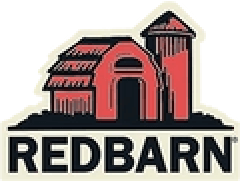
6 Essential Nutrients Dogs Need to Thrive
As responsible dog parents, we want to give our family the best, starting with the foods we feed them. Just like their humans, dogs require essential nutrients for their bodies to develop properly, for their energetic personalities to shine, and yes, even for their stools.
But with the pet food market more saturated than ever, it’s easy to feel overwhelmed with food choices. To complicate matters further, most companies say their food is “complete and balanced.” But, is all food created equal?
Definitely not.
So, how do you know what’s truly best for your pet? At Redbarn, we believe feeding your dog is something you should feel confident about, no second-guessing.
To get through the clutter, dog parents should follow three steps— learn the six essential nutrients every dog needs, find out how much to feed their dog, and how to utilize this knowledge when looking at food labels in the pet store.
Pet parents can take charge and become more knowledgeable about the essentials of pet nutrition by reading educational blogs (like this one!) and regularly speaking with their veterinarian.
“Knowing the essentials of pet nutrition is the first step in making sure you do not overspend on useless products,” Sandy Chebat told Pet Product News International. “Premiumization; new companies capitalizing on your pets being ‘family’ by converting families to higher-priced items. Marketing terms and medical jargon can be confusing to de-code alone.”
We’ve done the research for you and simplified the essentials in order to fix the problem. Let’s dig in so our pups can chow down!
Six Essential Nutrients Your Dog Needs
The six essential nutrients your dog needs include water, fat, protein, carbs, vitamins and minerals.
1. Water
Water makes up 70 to 80 percent of a mature dog’s body mass. Without water, your dog will not be able to function correctly. The purpose of water is to help the body dissolve and transport nutrients to cells, regulate body temperature, digest foods, flush away waste and much more. It’s important to make sure your dog has access to an adequate supply of clean water daily. Dogs should drink approximately one ounce of water per pound of body weight each day, according to PetMD, but consult your veterinarian for individual recommendations.
2. Fat
Fats protect internal organs, regulate body temperature, and promote a healthy nervous system. If fat levels are too low, dogs can also develop dry, itchy skin and dull coats. Dogs require certain fatty acids that their bodies cannot produce naturally. These fats are called essential fatty acids.
“It’s also important to note, for pet foods, calories are calculated a little differently than human foods. Protein and carbohydrates are assigned a value of 3.5 calories per gram. Fat is assigned 8.6 calories per gram. This is to account for the less processed ingredients typically used in pet foods.” Steve Doerr, Technical Director and Research & Development Scientist, at Redbarn Pet Products, said.
Not all fats are good for your dog. Carefully consider the source, quality, and quantity of the fat when choosing a quality dog food.
3. Protein
Protein produces energy and supplies the body what it needs to create a solid structure (skin, nails, muscles, and bones). The body cannot store protein, so it requires a constant supply. Proteins are made up of amino acids— dogs need 22 amino acids to produce the proteins necessary to survive. A dog’s body can naturally make about half of those amino acids, but the rest comes from the food your dog eats every day. Essential amino acids are, as the name hints at, essential to your dog’s health but sourced from food. Both the amount and the ratio of essential amino acids is important.
To ensure your dog is fueling their day and body with enough protein, look for dog foods with natural, high-quality proteins as the first ingredient. The type of protein— fish, meat, or poultry — is up to your dog’s personal taste preferences and any other specific dietary needs the protein source may provide. And rest assured, real meat, fish, or poultry, is always the first ingredient in Redbarn’s dog food.
4. Carbs
Carbohydrates serve as a primary source of fuel and are a dog’s main source of glucose (energy). Carbs are not essential to a dog’s diet; however, they are associated with important vitamins, minerals and plant-based nutrients. Grains, barley, brown rice, whole corn or potatoes are all examples of carbs.
5. Vitamins
Vitamins support many critical roles in your dog’s diet and are essential for growth and health maintenance. As long as your choice of dog food is a complete and balanced meal under AAFCO’s guidelines, your pup should be receiving many of the vitamins necessary to keep them healthy and happy.
- Vitamin D helps to regulate calcium and phosphorus levels
- Vitamin A helps to boost the immune system
- Vitamin E and C serve as antioxidants
- Vitamin K helps with blood clots and
- Vitamin B12 helps maintain a healthy nervous system
6. Minerals
Just like vitamins, minerals support several critical roles in a dog’s diet. While different minerals provide different benefits, some general functions include bone and cartilage formation, hormone regulation, oxygen flow, and nerve and muscle function. Below are some specific attributes of essential minerals for your dog.
- Calcium and phosphorus make up a large portion of bone matter
- Iron helps to carry oxygen through the body
- Zinc supports proper wound healing
- Selenium helps provide antioxidant support
- Sodium, potassium, calcium, and magnesium help with nerve transmission and fluid balance
Now we know the basics of what our four-legged friend needs to fuel his healthy lifestyle. But how does all this information become actionable?
Guaranteed Analysis:
The Nutrition Label of Pet Food
What is a Guaranteed Analysis?
All dog food labels list the minimum amount of protein and fat as well as the maximum percentage of fiber and moisture.
According to the scientific research unit of the National Research Academics Council, at least 10 percent of your dog’s daily diet should be protein, and 5.5 percent should be fat. But as always, consult your veterinarian for individual dietary needs.
Pro tip — bring your current dog food and treats with you on the next vet visit, or a picture of the label, and ask your vet to review the ingredients with you.
Ingredient List
Just like people food, pet food lists the ingredients by weight, starting with the largest percentage ingredient. The only way to be sure of what your dog is eating is to read the ingredient list.
Decoding the Label with The Name Game
The way a food is named is the first indicator of how much “good” ingredients are in the food. This is a great rule-of-thumb, but truly understanding it can be a little tricky.
According to the FDA, an ingredient list must be listed in the order of predominance in the food. When “beef” is the first ingredient listed, “whole grain corn” is the second, and “soybean meal” the third, for example, there is more beef than whole grain corn and more whole grain corn than soybean meal.
If the name of the food starts with meat (for example, Beef Dog Food), the food must have at least 95 percent of said meat.
Look For:
- Real meat as the first ingredient
- Fillers, if any, (corn, wheat, soy) should be listed low on the ingredients list
- If a “meal” is listed, be sure it’s from a specific source (ex: chicken, beef, or salmon), not a general “meal” (ex: poultry meal, fish meal, etc.)
- Specific protein by-products (ex: beef by-product) are high in nutritional value and generally are not an issue; but watch out for general statements (ex: by-product meal) as these are a lower in quality
Watch Out For:
- Name of food contains the statement “with” or “flavor” (ex: with beef or beef flavored) as this indicates a small percentage of real meat
- The same ingredient is listed multiple times using different names (ex: high fructose corn syrup, corn syrup, sugar, sucrose)
- Fillers in foods and treats or too many fillers in dog food (may not be biologically appropriate for your pet)
If the name of the food reads “recipe,“ “dinner,“ or “formula,“ the meat/ingredient in the name must be at least 25 percent of the food (for example, Salmon Formula for Cats). Using the example from above, changing the name to be “Beef Dog Food Recipe,“ the beef content goes down from 95 percent to anywhere from 25 to 95 percent.
If there are two or more meats listed in the name, like “Chicken and Salmon Dinner for Cats,” the food must have a combined 25 percent of BOTH types of meat. This specific example indicates that there is more chicken than salmon because chicken is listed first in the name.
If the word “with” is listed in the name, this lets us know that there is an even smaller amount of the meat in the food—only 3 percent. For example, “Dog Food with Chicken” is only required to have 3 percent chicken to meet the required amount.
Finally, if the food name has the word “flavor,” it has at least 3 percent of meat (for example, Salmon Flavored Cat Food). Using the word “flavor” in the name only legally requires 3 percent of the meat to be present in the recipe.
These verbiage rules don’t only apply to meat, though. It goes with any food callout on the packaging, including superfood callouts which many companies are currently drawing attention to.
You can learn more about how to read pet food labels with Redbarn’s helpful guide, “Decoding the Label 101.”
Customer Service Hotline
The packaging label should contain the manufacturer’s name and phone number. Call the company’s customer service line directly to learn more about their products, including manufacturing origin, actual nutrient content, calories, and palatability of your prospective dog food choice.
If you ever have a question or concern about Redbarn Pet Products, feel free to reach out to our customer service team at 1-800-775-3849 or direct message us on our social media channels.
Feed Confidently
You can now feel more confident when shopping for the right products for your four-legged family member.
Properly educated pet parents have an easier time picking the right options for their pets. An essential nutrition knowledge base is crucial in proper pet parenting. This will help protect you and your wallet from trends and supplements that are overpriced and non-essential to your pet’s health.


